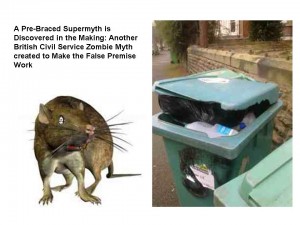By Mike Sutton.
Mythbusting the mythbusters and their super myth making
On the 17th December the BBC (Prichard, C. 2012 ) set about debunking the old maxim that “you are never more than six feet away from a rat”.
To make dysological matters worse, that old rural myth is today generally applied to people and rats in urban settings.
In order to come up with a better urban rat proximity figure it looks like a pre-supermyth has been created.
Weirdly homogenizing the diverse complexity of urban Britain in a new calculation that lumps all port towns and cities, medieval cities, and new towns together, Prichard’s BBC article cites calculations by Dr Dave Cowan, leader of Britain’s wildlife programme (civil servant) at the Food and Environment Research Agency to suggest that a better estimate, but one with less of a memorable ring to it, is that we are in fact never more than 164 feet (50 meters) away from a rat.
However, just a little thoughtfulness reveals a massive problem regarding how this new calculation was arrived at. Because the BBC article uses a debunking premise that is very much like the irrational British Civil Service reasoning behind the Zombie Cop Myth (Sutton and Hodgson 2011) in that :
If we distribute the rats evenly across the urban areas, which is clearly unlikely but necessary for the calculation, each rat has a rather spacious 5,000 square metres to roam around in.
Can you smell a rat in the above reasoning?
Looks Like another Zombie Myth.
Just as police do not patrol randomly through an urban terrain where crime is uniformly spread (a premise that was necessary for the Zombie Copy 100 yard Myth calculation See: Sutton and Hodgson 2011) the uniform distribution of rats is an extremely daft premise upon which to build a calculation about rats – given that they are a communal animal. Worse, it’s internally incongruous because the BBC article notes earlier on that :
“Rats are almost completely commensal in Britain, [meaning] they’re associated with human activities. That gives us a start because we only really need to think about how many rats there might be living in close proximity to ourselves.”
Therefore, the new rat proximity calculation is spurious because:
1. Neither humans nor rats are evenly spread out and rats follow human activity
2. Human activities are not evenly spread out
3. Human dwellings are not evenly spread out
4. Urban areas contain many miles of roads, parklands, rivers, railways, shopping centres and gardens etc . They certainly are not comprised entirely of dwellings.
5. Neither humans nor rats wander around randomly like headless zombies. Rats go specifically to and are concentrated in places where human activities create rat friendly environments.
Hence the premise for equally distributed rats that is necessary for the calculation renders it absolute bullony.
To repeat the point made above, if rats are social animals and urban rat location is determined by human activities – and, thankfully, humans are not spread out evenly anywhere in the UK – then it’s utter nonsense to have a calculation of rat proximity to humans based upon the assumption that rats are uniformly spread out over every square mile of urban areas. Moreover, some cities are surely more rat friendly than others, which must make the homogenized Britain part of the calculation yet more spurious.
The popular and ‘expert’ allure of over simplistic-bad science
Unfortunately, the result of the new rat proximity calculation is just as much bullony as the old one. And it serves no useful purpose whatsoever other than to teach us a valuable lesson about how spurious premises, which are necessary for such arithmetical calculations, leave us with nothing more than pre-supermyths (see Sutton 2012) or more precisely braced pre–supermyths.
Braced myths go a stage further than normal supermyths, which are unintentionally created by experts with great irony in the spirit of skeptical e
nquiry Braced myths are supermyths that are used as a tool to bust other myths.
Finally, I would like also to take this opportunity to bust the fallacy that British wheelie bins are RAT proof. The local authority pest control office informed my wife in the summer that a large solitary wandering rat (not one living in our garden) had chewed through the lid of our neighbours dustbin in Nottingham. You can see how it chewed right through the bin lid – left . Consequently, this is disconfirming evidence that either my neighbour or the rat, me or my wife, or the pest control officer, are headless zombies. I’m not so sure about British Civil Servants however.
Follow further Dysology on Twitter
References
Full Harvard style references available for this article whre first published Best Thinking.com: here



